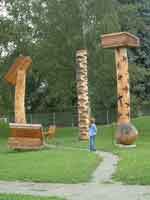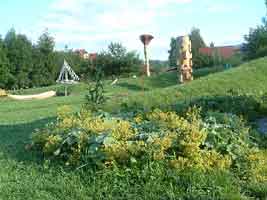
Site Contents
About Us
Contact Us
Events
Products
Scythe Buyers' Guide
Technical/
Instructional
Updates
Video
Home

SCYTHE SYMPOSIUM AND
PRACTICAL SESSIONS
NATURPARK GREBENZEN
Neumarkt, Austria
14-15 July 2006
 |  |  |
CONCEPT:
Its practicality proven throughout centuries of use, the scythe has remained a tool of importance in many countries and over large areas of the world. With the changes in agriculture, this essential segment of Folk Culture has been left behind. The various mowing machines, including the homeowner's "power scythe", have to a large degree displaced the traditional scythe.
This in turn led to the loss of the necessary scythe-related knowledge so that the younger generation of farmers often had not learned the proper edge maintenance of this tool (especially the peening). Shopping in garden centres or farm stores, one can rarely find competent advice regarding the fitting, adjusting and sharpening. Along with scythe knowledge, the related country lore has of course also suffered.
As the issues of energy use, biodiversity and the health of the environment receive greater attention, the demand for this old example of efficient and - given present circumstances - appropriate technology is on the increase. Somewhat of a Scythe Renaissance is now emerging in Europe.
One of the premises of this Symposium is that the scythe has considerable potential in helping us meet recent commitments to the goals set by the Kyoto Protocol and the Biological Diversity Convention. Thousands of hectares of grass-covered landscape, both urban (lawns, parks, playgrounds) and rural (roadsides, conservation areas, nature trails etc.) can be cut in a far more sustainable and pollution-free manner.
Using the scythe in ecologically sensitive areas can make a major contribution to the preservation of biodiversity. In addition, the use of the scythe offers:
The combined effect of the above - besides lower national health care costs - is a higher quality of life.
VISIONS AND GOALS:
The Symposium will re-awaken the appreciation of the scythe's role as an important cultural and economic factor influencing the development of a nation. Building from this realization, we shall point out the scythe's usefulness in the future. The presentation and discussion format of the Symposium could help us develop strategies for the application of the scythe in landscape care, its commercial production "at its best" along with qualified professional marketing. By virtue of the international participation we will have an opportunity for the exchange and furthering of cultural perspectives.
PROGRAMME:FRIDAY, 14 July:
Peter Vido and DI Adolf Staufer: Introducing new developments related to the scythe and hand mowing
Peter Vido: Mowing as Physical and Mental Therapy (relating the use of the scythe to the practice of Tai-chi)
Professor Dr. Otto Fleiß: Mowing and Health - Biomechanics and Ergonomy of Mowing with the Scythe
Graz Ethnological Institute: The Scythe in Folk Culture
Dipl. Ing. Adolf Staufer: The Contribution of the Body's Energy to the Alternative Energy Source: A Return to a Human Measure of Energy Use
The entertainment will be provided in co-operation with local groups (Music associations, singers' group, farmers etc.) as well as Steyr's Folksong Association.
SATURDAY, 15 July:Peter Vido and other members of Sensenverein Osterreich: Practical Workshops
Entertaining activities:
Mowing Competition of the local Youth Association
Comparing the hand scythe with the "power scythe"
Design Mowing (Logo of the Nationalpark)
Obstacle Course Mowing
22 Mar. 2006
Modified 15 Apr. 2006